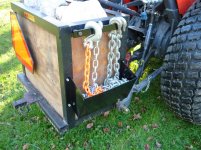varmint
Elite Member
- Joined
- Mar 17, 2003
- Messages
- 2,576
- Location
- Northern Maryland
- Tractor
- Kubota B8200, then a Kubota L3130 HST, now a Kubota L3400 HST
Again, lots of advice, most of it relevant to the OP's questions. Seems like, for his purposes, some wheel spacers and a weight box would be the ticket. My home made weight box cost me about $100 for steel and fittings, plus some time welding and painting, but no big deal. I can add or remove rock as needed, and the whole thing comes right off, if rear weight won't be needed and I am concerned about compaction.
I am against calcium chloride because the wheels on our old L3130 were filled with it, and their were some serious corrosion issues where the tire and rim came together, which I was told were caused by the fill. Seemed like a correct assessment, but that's the extent of my knowledge.
Weight box: 2 x 2 x 1/4 angle, 1/2" ext. plywood, some scrap tube and part of an old trailer hitch. Only about 5-600 lbs, but enough. I find the chain racks very handy.


I am against calcium chloride because the wheels on our old L3130 were filled with it, and their were some serious corrosion issues where the tire and rim came together, which I was told were caused by the fill. Seemed like a correct assessment, but that's the extent of my knowledge.
Weight box: 2 x 2 x 1/4 angle, 1/2" ext. plywood, some scrap tube and part of an old trailer hitch. Only about 5-600 lbs, but enough. I find the chain racks very handy.


